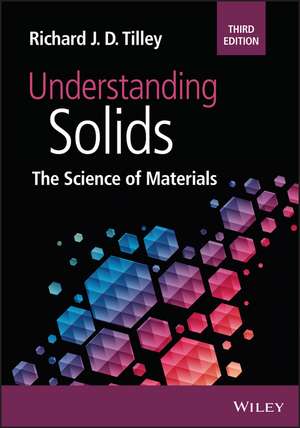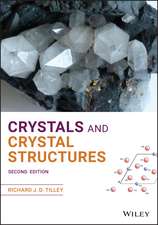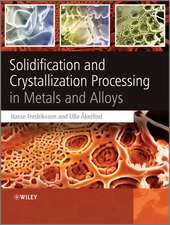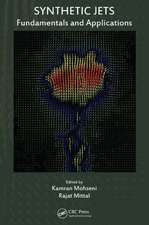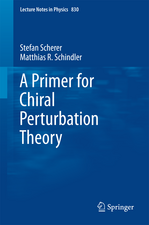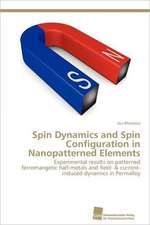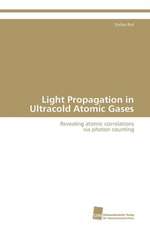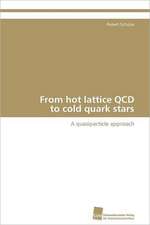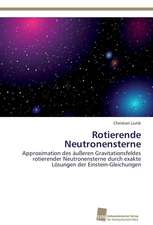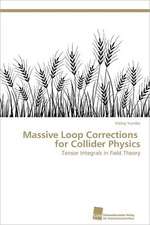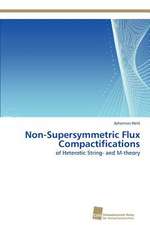Understanding Solids – The Science of Materials, 3rd Edition
Autor RJD Tilleyen Limba Engleză Paperback – 23 iun 2021
Preț: 481.76 lei
Preț vechi: 625.66 lei
-23% Nou
Puncte Express: 723
Preț estimativ în valută:
92.19€ • 98.58$ • 76.86£
92.19€ • 98.58$ • 76.86£
Carte tipărită la comandă
Livrare economică 17 aprilie-01 mai
Preluare comenzi: 021 569.72.76
Specificații
ISBN-13: 9781119716501
ISBN-10: 1119716500
Pagini: 624
Dimensiuni: 181 x 252 x 33 mm
Greutate: 1.07 kg
Ediția:3rd Edition
Editura: Wiley
Locul publicării:Chichester, United Kingdom
ISBN-10: 1119716500
Pagini: 624
Dimensiuni: 181 x 252 x 33 mm
Greutate: 1.07 kg
Ediția:3rd Edition
Editura: Wiley
Locul publicării:Chichester, United Kingdom
Cuprins
Preface xix
Part I States of Aggregation 1
1 Atoms and Bonding 3
1.1 The Electron Structure of Atoms 3
1.1.1 Hydrogen 3
1.1.2 Many Electron Atoms 4
1.1.3 Orbital Shapes 6
1.1.4 Electron Spin and Electron Configuration 8
1.1.5 Atomic Energy Levels 9
1.2 Ionic Bonding 12
1.2.1 Ionic Size and Bonding 12
1.2.2 Lattice Energies 13
1.2.3 Atomistic Simulation 14
1.3 Covalent Bonding 15
1.3.1 Bond Geometry 15
1.3.2 Bond Energies 18
1.4 Metallic Bonding 21
1.4.1 Molecular Orbitals and Energy Bands 21
1.4.2 The Free Electron Gas 22
1.4.3 Energy Bands 24
1.4.4 Bands in Ionic and Covalent Solids 27
1.5 Weak Chemical Bonds 28
1.6 Computation of Material Properties 31
Further Reading 31
The Following References Expand the Material in this Chapter 31
A Dictionary of Quantum Mechanical Language and Expressions is 32
Ionic Radii are Discussed and Tabulated by 32
The Computation of Properties is Described in 32
Problems and Exercises 32
Calculations and Questions 34
2 Microstructures and Phase Relationships 37
2.1 Macrostructure, Microstructure, and Nanostructure 37
2.1.1 Crystalline Solids 37
2.1.2 Non-crystalline Solids 37
2.1.3 Partly Crystalline Solids 40
2.1.4 Nanoparticles and Nanostructures 40
2.2 The Development of Microstructures 43
2.2.1 Solidification 43
2.2.2 Processing 44
2.3 Phase Diagrams 45
2.3.1 One-Component (Unary) Systems 45
2.3.2 Two-Component (Binary) Systems 48
2.3.2.1 Simple Binary Diagrams: Nickel-Copper as an Example 48
2.3.2.2 Binary Systems Containing a Eutectic Point: Tin-Lead as an Example 49
2.3.2.3 Intermediate Phases 52
2.3.2.4 The Iron-Carbon System Close to Iron 52
2.4 Ternary Systems 54
References 57
Further Reading 58
Problems and Exercises 58
Calculations and Questions 60
3 Crystal Structures and Defects 65
3.1 Crystal Geometry 65
3.1.1 Crystal Systems 65
3.1.2 Crystal Lattices 66
3.1.3 Symmetry and Crystal Classes 68
3.2 Crystal Structures 69
3.2.1 Unit Cells and Atomic Coordinates 69
3.2.2 Crystal Structures 70
3.2.2.1 The Face-Centred Cubic (fcc, A1) Structure 70
3.2.2.2 The Body-Centred Cubic (bcc, A2) Structure 70
3.2.2.3 The Hexagonal Close-Packed (hcp, A3) Structure 70
3.2.2.4 The Diamond Structure 71
3.2.2.5 The Graphite Structure 71
3.2.2.6 The Halite (Rock Salt, Sodium Chloride) Structure 71
3.2.2.7 The Perovskite Structure 72
3.2.2.8 The Spinel Structure 72
3.2.2.9 Lattice Parameters and Vegard's Law 74
3.3 Crystal Planes and Directions 74
3.3.1 Miller Indices 74
3.3.2 Hexagonal Crystals and Miller-Bravais Indices 76
3.3.3 Directions 78
3.3.4 Interplanar Spacings 79
3.4 Crystal Density 80
3.4.1 Density Estimation 80
3.4.2 The Density of NaCl 81
3.4.3 The Density of Crystals with a Variable Composition 81
3.5 Structural Relationships 82
3.5.1 Sphere Packing 82
3.5.2 Ionic Structures in Terms of Anion Packing 84
3.5.3 Polyhedral Representations 86
3.6 Point Defects 87
3.6.1 Point Defects in Crystals of the Elements 88
3.6.2 Solid Solutions 89
3.6.3 The Schottky and Frenkel Defects 90
3.6.4 Non-stoichiometric Compounds 91
3.6.5 Point Defect Notation 93
3.7 Linear, Planar, and Volume defects 95
3.7.1 Dislocations 95
3.7.2 Planar Defects 96
3.7.3 Volume Defects: Precipitates 99
Reference 99
Further Reading 100
Crystal Structures 100
Defects 100
Problems and Exercises 100
Calculations and Questions 102
4 Solids: Overview 109
4.1 Metals 109
4.1.1 Structures 109
4.1.2 Metallic Radii 110
4.1.3 Alloy Solid Solutions 112
4.1.4 Metallic Glasses and Quasicrystals 115
4.1.5 The Principal Properties of Metals 116
4.2 Crystalline Silicates and Inorganic Ceramic Materials 118
4.2.1 Silicate Structures 119
4.2.2 Some Non-silicate Ceramics 122
4.2.3 The Preparation and Processing of Ceramics 125
4.2.4 The Principal Properties of Ceramics 126
4.3 Silicate Glasses 126
4.3.1 Bonding and Structure of Silicate Glasses 127
4.3.2 Glass Deformation 129
4.3.3 Strengthened Glass 131
4.3.4 Glass-Ceramics 132
4.4 Polymers and Organic Materials 133
4.4.1 Polymers 133
4.4.2 Polymer Formation 134
4.4.3 Microstructures of Polymers 138
4.4.4 Elastomers 143
4.4.5 Production of Polymers 145
4.4.6 Organic Framework Structures: MOFs and COFs 148
4.4.7 The Principal Properties of Polymers 151
4.5 Composite Materials 152
4.5.1 Fibre-Reinforced Materials 152
4.5.2 Cement and Concrete 154
Reference 157
Further Reading 157
Metals 157
Bulk Metallic Glasses 157
Ceramics and Glass 157
Zeolites 157
Polymers 157
Metal-organic Frameworks 158
Covalent Organic Frameworks 158
Composites 158
Problems and Exercises 158
Calculations and Questions 160
Part II Reactions and Transformations 165
5 Diffusion and Ionic Conductivity 167
5.1 Self-Diffusion and Tracer Diffusion 167
5.2 Non-steady-state and Steady-State Diffusion 169
5.3 Temperature Variation of Diffusion Coefficient 171
5.4 The Effect of Impurities 171
5.5 RandomWalk Diffusion 171
5.6 Diffusion in Solids 175
5.7 Self-Diffusion in One Dimension 176
5.8 Self-Diffusion in Crystals 178
5.9 The Arrhenius Equation and Point Defects 178
5.10 Correlation Factors for Self-Diffusion 180
5.11 Ionic Conductivity 181
5.12 The Relationship Between Ionic Conductivity and Diffusion Coefficient 183
5.13 Superionic Conductors 184
5.13.1 Disordered Cation Compounds 184
5.13.2 ß-Alumina Oxides 185
5.13.3 Stabilised Zirconia Oxides 188
5.13.4 NASICON-Related Crystals 188
References 189
Further Reading 189
Superionic Conductors: See Also References Therein 190
Problems and Exercises 190
Calculations and Questions 191
6 Phase Transformations and Reactions 195
6.1 Sintering 195
6.1.1 Sintering and Reaction 195
6.1.2 The Driving Force for Sintering 197
6.1.3 The Kinetics of Neck Growth and Grain Growth 198
6.1.4 Rapid Sintering 198
6.2 Phase Transitions 199
6.2.1 First-Order Phase Transitions 200
6.2.2 Second-Order Transitions 201
6.3 Displacive and Reconstructive Transitions 201
6.3.1 Displacive Transitions 201
6.3.2 Reconstructive Transitions 203
6.4 Order-Disorder Transitions 204
6.4.1 Positional Ordering 205
6.4.2 Orientational Ordering 205
6.5 Martensitic Transformations 206
6.5.1 The Austenite-Martensite Transition 207
6.5.2 Martensitic Transformations in Zirconia 210
6.5.3 Martensitic Transitions in Ni-Ti Alloys 211
6.5.4 Shape-Memory Alloys 212
6.6 Phase Diagrams and Microstructures 214
6.6.1 Equilibrium Solidification of Simple Binary Alloys 214
6.6.2 Non-equilibrium Solidification and Coring 214
6.6.3 Solidification in Systems Containing a Eutectic Point 216
6.6.4 Equilibrium Heat Treatment of Steel in the Fe-C Phase Diagram 218
6.7 High Temperature Oxidation of Metals 220
6.7.1 Direct Corrosion 220
6.7.2 The Rate of Oxidation 222
6.7.3 Oxide Film Microstructure 222
6.7.4 Film Growth via Diffusion 223
6.7.5 Alloys 225
6.8 Solid-State Reactions 225
6.8.1 Spinel Formation 225
6.8.2 Photoresists 227
6.8.3 Mechanochemistry 229
Further Reading 230
Sintering and 3D Printing 230
High Temperature Oxidation and Solid-State Reactions 230
For Mechanochemistry See 231
Problems and Exercises 231
Calculations and Questions 233
7 Oxidation and Reduction 239
7.1 Galvanic Cells 239
7.1.1 Cell Basics 239
7.1.2 Standard Electrode Potentials 241
7.1.3 Cell Potential, Gibbs Energy, and Concentration Dependence 243
7.2 Chemical Analysis Using Galvanic Cells 243
7.2.1 pH Meters 243
7.2.2 Ion Selective Electrodes 245
7.2.3 Oxygen Sensors 246
7.3 Batteries 247
7.3.1 Primary Batteries 248
7.3.1.1 'Dry' and Alkaline Primary Batteries 248
7.3.1.2 Lithium-Ion Primary Batteries 249
7.3.1.3 Lithium-Air Batteries 249
7.3.2 Fuel Cells 250
7.3.3 Secondary Batteries 252
7.3.3.1 The Lead-Acid Battery 252
7.3.3.2 Lithium-Ion Batteries 253
7.3.3.3 Dual-Ion Batteries 254
7.4 Corrosion 255
7.4.1 The Reaction of Metals withWater and Aqueous Acids 256
7.4.2 Dissimilar Metal Corrosion 257
7.4.3 Single Metal Electrochemical Corrosion 259
7.5 Electrolysis 260
7.5.1 Electrolytic Cells 260
7.5.2 Electroplating 261
7.5.3 The Amount of Product Produced During Electrolysis 262
7.5.4 The Electrolytic Preparation of Titanium by the FFC Cambridge Process 263
7.6 Pourbaix Diagrams 264
7.6.1 Passivation, Corrosion, and Leaching 264
7.6.2 The Stability Field ofWater 265
7.6.3 Pourbaix Diagrams for a Metal Showing Two Valence States 265
7.6.4 Pourbaix Diagram Displaying Tendency for Corrosion 268
Reference 268
Further Reading 269
For a General Introduction to Electrochemistry See 269
Structure-property Relations and Defects in Electrode and Electrolyte Solids is
Described in 269
Batteries 269
Solid Oxide Fuel Cells 269
Corrosion 270
Electroplating 270
Problems and Exercises 270
Calculations and Questions 271
Part III Physical Properties 275
8 Mechanical Properties of Solids 277
8.1 Strength and Hardness 277
8.1.1 Strength 277
8.1.2 Stress and Strain 278
8.1.3 Toughness and Stiffness 280
8.1.4 Superelasticity 282
8.1.5 Hardness 283
8.2 Elastic Moduli 285
8.2.1 Young's Modulus (The Modulus of Elasticity) (E or Y) 286
8.2.2 Poisson's Ratio (nu) 288
8.2.3 The Longitudinal or Axial Modulus (L or M) 289
8.2.4 The Shear Modulus (G or mu), Bulk Modulus (K or B), and Lamé Modulus (lambda) 289
8.2.5 Relationships Between the Elastic Moduli 290
8.2.6 UltrasonicWaves in Elastic Solids 290
8.3 Deformation and Fracture 291
8.3.1 Brittle Fracture 291
8.3.2 Plastic Deformation of Metals 294
8.3.3 Brittle and Ductile Materials 297
8.3.4 Plastic Deformation of Polymers 299
8.3.5 Fracture Following Plastic Deformation 299
8.3.6 Strengthening 301
8.3.7 Computation of Deformation and Fracture 303
8.4 Time-Dependent Properties 304
8.4.1 Fatigue 304
8.4.2 Creep 305
8.5 Nanoscale Properties 309
8.5.1 Solid Lubricants 309
8.5.2 Auxetic Materials 310
8.5.3 Thin Films and Nanowires 312
8.6 Composite Materials 315
8.6.1 Elastic Modulus of Fibre Reinforced Composites 315
8.6.2 Elastic Modulus of a Two-Phase System 316
Further Reading 318
Ductility and Fracture 318
Mechanical Properties of Biological Materials 318
Hall-Petch Effect 318
Computation of Properties 318
Finite Element Methods 319
Nanoscale Methods 319
Composites 319
Problems and Exercises 319
Calculations and Questions 321
9 Insulating Solids 327
9.1 Dielectrics 327
9.1.1 Relative Permittivity and Polarisation 327
9.1.2 Polarisability 330
9.1.3 The Relative Permittivity of Crystals 332
9.2 Piezoelectrics, Pyroelectrics, and Ferroelectrics 334
9.2.1 The Piezoelectric and Pyroelectric Effects 334
9.2.2 Crystal Symmetry and the Piezoelectric and Pyroelectric Effects 335
9.2.3 Piezoelectric Mechanisms 337
9.2.4 Quartz Oscillators 338
9.2.5 Piezoelectric Polymers and Biomolecular Materials 339
9.3 Ferroelectrics 342
9.3.1 Ferroelectric and Antiferroelectric Crystals 343
9.3.2 Hysteresis and Domain Growth in Ferroelectric Crystals 345
9.3.3 The Temperature Dependence of Ferroelectricity and Antiferroelectricity 347
9.3.4 Ferroelectricity Due to Hydrogen Bonds 347
9.3.5 Ferroelectricity Due to Polar Groups 349
9.3.6 Ferroelectricity Due to Medium-Sized Transition-Metal Cations 350
9.3.7 Modification of Properties 352
9.3.8 Relaxor Ferroelectrics 354
9.3.9 Ferroelectric Nanoparticles, Thin Films, and Superlattices 354
9.3.10 Flexoelectricity in Ferroelectrics 356
Reference 358
Flexoelectric Effect 358
Further Reading 358
General 358
Introductory Crystallography with Respect to the Dielectric Properties 358
The Dielectric, Piezoelectric and Ferroelectric Properties of Perovskite Structures are
Detailed in 358
Biomolecular Materials are Described in 358
Nanoparticle, Thin Films and Superlattices 358
Problems and Exercises 359
Calculations and Questions 360
10 Magnetic Solids 365
10.1 Magnetic Materials 365
10.1.1 Characterisation of Magnetic Materials 365
10.1.2 Magnetic Dipoles and Magnetic Flux 366
10.1.3 Atomic Magnetism 368
10.1.4 Overview of Magnetic Materials 369
10.2 Paramagnetic Materials 372
10.2.1 The Magnetic Moment of Paramagnetic Atoms and Ions 372
10.2.2 High and Low Spin: Crystal Field Effects 373
10.2.3 Temperature Dependence of Paramagnetic Susceptibility 376
10.2.4 Pauli Paramagnetism 378
10.3 Ferromagnetic Materials 379
10.3.1 Ferromagnetism 379
10.3.2 Exchange Energy 380
10.3.3 Domains 382
10.3.4 Hysteresis 384
10.3.5 Hard and Soft Magnetic Materials 385
10.4 Antiferromagnetic Materials and Superexchange 386
10.5 Ferrimagnetic Materials 387
10.5.1 Cubic Spinel Ferrites 387
10.5.2 Garnet Structure Ferrites 388
10.5.3 Hexagonal Ferrites 389
10.5.4 Double Exchange 390
10.6 Nanostructures 391
10.6.1 Small Particles and Data Recording 391
10.6.2 Superparamagnetism and Thin Films 391
10.6.3 Perovskite Superlattices 392
10.6.4 Photoinduced Magnetism 393
10.7 Magnetic Defects 395
10.7.1 Magnetic Defects in Semiconductors 395
10.7.2 Charge and Spin States in Cobaltites and Manganites 396
Further Reading 399
General 399
Magnetic States 399
A Starting Point for the Detection of Magnetic Fields by Animals 400
Density Functional Theory Calculations of Magnetic Properties is Outlined by 400
Magnetic Superlattices 400
A Starting Point for Studies on Photomagnetism 400
Problems and Exercises 400
Calculations and Questions 402
11 Electronic Conductivity in Solids 405
11.1 Metals 405
11.1.1 Metals, Semiconductors, and Insulators 405
11.1.2 Electronic Conductivity 407
11.1.3 Resistivity 410
11.2 Semiconductors 411
11.2.1 Intrinsic Semiconductors 411
11.2.2 Band Gap Measurement 412
11.2.3 Extrinsic Semiconductors 413
11.2.4 Carrier Concentrations in Extrinsic Semiconductors 415
11.2.5 Characterisation 416
11.2.6 The p-n Junction Diode 419
11.3 Metal-Insulator Transitions 422
11.3.1 Metals and Insulators 422
11.3.2 Electron-Electron Repulsion 423
11.3.3 Modification of Insulators 425
11.3.4 Transparent Conducting Oxides 426
11.4 Conducting Polymers 427
11.5 Superconductivity 431
11.5.1 Superconductors 431
11.5.2 The Effect of Magnetic Fields and Current 432
11.5.3 The BCS Theory of Superconductivity 434
11.5.4 Josephson Junctions 435
11.5.5 Cuprate High Temperature Superconductors 437
11.5.5.1 Lanthanum Cuprate, La2CuO4 437
11.5.5.2 Neodymium Cuprate, Nd2CuO4 438
11.5.5.3 Yttrium Barium Copper Oxide, YBa2Cu3O7 439
11.5.5.4 Perovskite-Related Structures and Series 440
11.5.6 Bi-layer Graphene 444
11.6 Nanostructures and Quantum Confinement of Electrons 445
Further Reading 447
The Band Theory Definition of a Semiconductor is Due to A.H. Wilson 447
Conductivity of (Mainly) Inorganic Solids Due to Defects is Covered In 447
The Metal-Insulator Transition in VO2 447
Polymers 447
Superconductivity 447
The Following Articles in Scientific American Give a Good Overview of the Early Years
of High Temperature Superconductivity 448
Graphene Bilayers 448
Quantum Hall Effect 448
Problems and Exercises 448
Calculations and Questions 450
12 Optical Aspects of Solids 455
12.1 Light 455
12.1.1 LightWaves 455
12.1.2 Photons 457
12.1.3 Colour and Appearance 459
12.2 Sources of Light 460
12.2.1 Incandescence 460
12.2.2 Luminescence 461
12.2.3 Fluorescent Lamps 463
12.2.4 Light Emitting Diodes (LEDs) 464
12.2.5 Organic Light Emitting Devices/Diodes (OLEDs) 467
12.2.6 Solid-State Lasers 469
12.2.6.1 The Ruby Laser: Three-Level Lasers 471
12.2.6.2 The Neodymium (Nd3+) Solid State Laser: Four-Level Lasers 473
12.2.6.3 Semiconductor Lasers 474
12.3 Refraction 474
12.3.1 The Refractive Index 474
12.3.2 Refractive Index and Structure 477
12.4 Reflection 477
12.4.1 Reflection from a Surface 477
12.4.2 Reflection from a Transparent Thin Film 478
12.4.3 Low-Reflectivity (Antireflection) and High-Reflectivity Coatings 482
12.4.4 Multiple Thin Films and Dielectric Mirrors 483
12.5 Scattering and Attenuation 483
12.5.1 Scattering 483
12.5.2 Attenuation 485
12.6 Diffraction 486
12.6.1 Diffraction by an Aperture 486
12.6.2 Diffraction Gratings 487
12.6.3 Diffraction from Crystal-like Structures 488
12.6.4 Holograms 490
12.6.4.1 Hologram Formation 490
12.6.4.2 Hologram Recording Media 492
12.7 Fibre Optics 493
12.7.1 Attenuation in Glass Fibres 493
12.7.2 Dispersion and Optical Fibre Design 494
12.7.3 Optical Amplification 496
12.8 Energy Conversion 496
12.8.1 Photoconductivity and Photovoltaic Solar Cells 496
12.8.2 Dye-Sensitised Solar Cells 497
12.8.3 Perovskite Solar Cells 499
12.9 Nanostructures 501
12.9.1 The Optical Properties of QuantumWells 502
12.9.2 The Optical Properties of Nanoparticles 502
12.9.3 Nanoparticle Arrays 504
Further Reading 506
General 506
Much of the Material in this Chapter is Covered in Greater Detail in 506
The Properties of Light with Respect to Colour are Found in 506
The Engineering Aspects of Optical Fibres are Described by 506
Perovskite Solar Cells are Described in 506
For Nanostructures and Surfaces See the Following Review Articles and References
Therein 506
Problems and Exercises 507
Calculations and Questions 509
13 Thermal Properties of Solids 515
13.1 Heat Capacity 515
13.1.1 The Heat Capacity of a Solid 515
13.1.2 Theories of Heat Capacity 515
13.1.3 Heat Capacity at Phase Transitions 517
13.2 Thermal Conductivity 518
13.2.1 Heat Transfer 518
13.2.2 Thermal Conductivity and Microstructure 520
13.3 Expansion and Contraction 522
13.3.1 Thermal Expansion 522
13.3.2 Thermal Expansion and Interatomic Potentials 523
13.3.3 Thermal Contraction 524
13.3.4 Zero Thermal Contraction Materials 526
13.4 Thermoelectric Effects 527
13.4.1 Thermoelectric Coefficients 527
13.4.2 Thermoelectric Effects and Charge Carriers 529
13.4.3 The Seebeck Coefficient of Solids Containing Point Defect Populations 530
13.4.4 Thermocouples, Power Generation, and Refrigeration 531
13.5 The Magnetocaloric Effect 533
13.5.1 The Magnetocaloric Effect and Adiabatic Cooling 533
13.5.2 The Giant Magnetocaloric Effect 534
13.6 Thermochromic Effects 535
13.6.1 Liquid Crystal Display Thermometers 535
13.6.2 Vanadium Dioxide 537
References 537
Further Reading 538
General 538
An Interactive Demonstration of the Debye Formula for the Heat Capacity of
Solids Is 538
Thermal Conductivity 538
Negative and Zero Thermal Expansion 538
The Magnetocaloric Effect in Alloys 538
Thermoelectric Materials 538
Problems and Exercises 539
Calculations and Questions 540
Part IV Nuclear Properties of Solids 543
14 Radioactivity and Nuclear Reactions 545
14.1 Radioactivity 545
14.1.1 Naturally Occurring Radioactive Elements 545
14.1.2 Isotopes and Nuclides 546
14.1.3 Nuclear Equations 546
14.1.4 Radioactive Series 547
14.1.4.1 The Uranium Series 547
14.1.4.2 The Thorium Series 548
14.1.4.3 The Actinium Series 548
14.1.4.4 The Neptunium/Plutonium Series 550
14.1.5 Nuclear Stability 550
14.2 Artificial Radioactive Atoms 551
14.2.1 Heavy Elements 551
14.2.2 Artificial Radioactivity in Light Elements 553
14.3 Nuclear Decay 554
14.3.1 The Rate of Nuclear Decay 554
14.3.2 Radioactive Dating 555
14.4 Nuclear Energy 557
14.4.1 The Binding Energy of Nuclides 557
14.4.2 Nuclear Fission 558
14.4.3 Thermal Reactors for Power Generation 560
14.4.4 Fuel for Space Exploration 561
14.4.5 Fast Breeder Reactors 561
14.4.6 Fusion and Solar Cycles 562
14.5 NuclearWaste 563
14.5.1 Nuclear Accidents 563
14.5.2 The Storage of NuclearWaste 564
Further Reading 565
The Search for New Heavy Elements 565
Radioactive Dating 565
Nuclear Reactors 566
NuclearWaste 566
Problems and Exercises 566
Calculations and Questions 568
Appendix A 571
Appendix B Energy Levels and Terms of Many-Electron Atoms 573
B.1 Derivation of Atomic Terms 573
B.2 The Ground State Term of an Atom 574
B.3 Energy Levels of Many Electron Atoms 575 Index 577
Notă biografică
Richard J.D. Tilley [INFO NOT INCLUDED]
